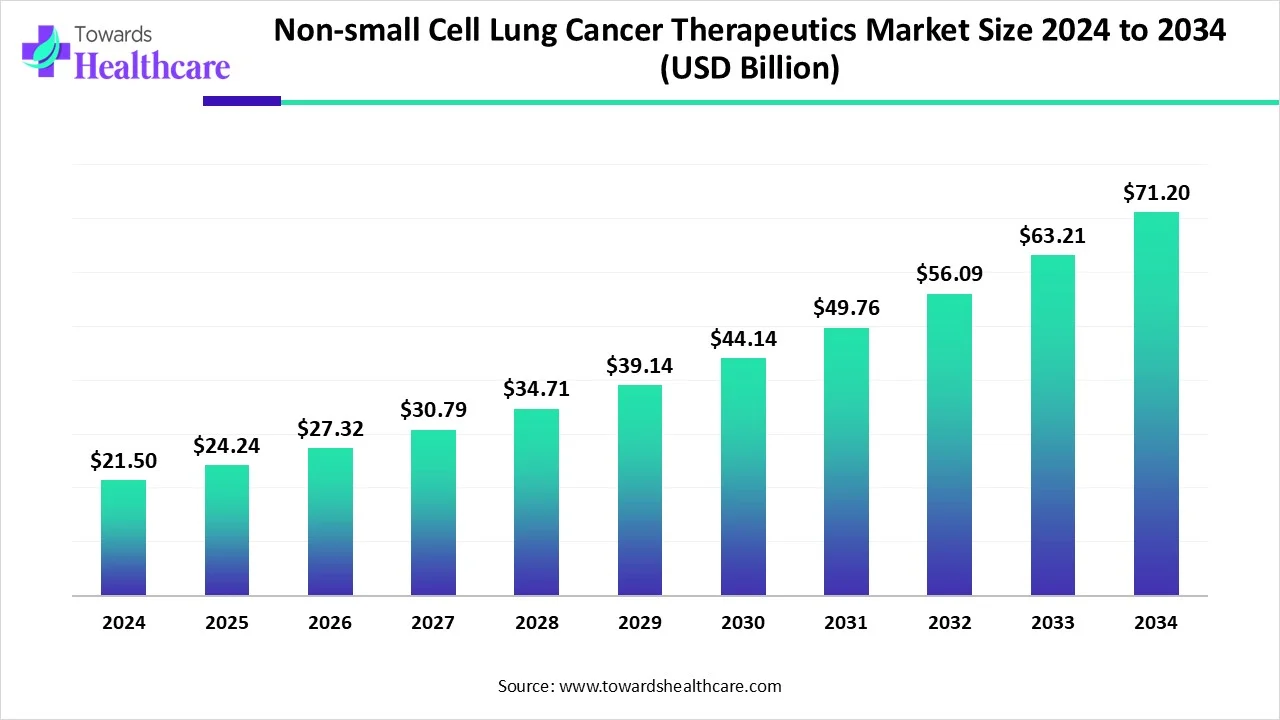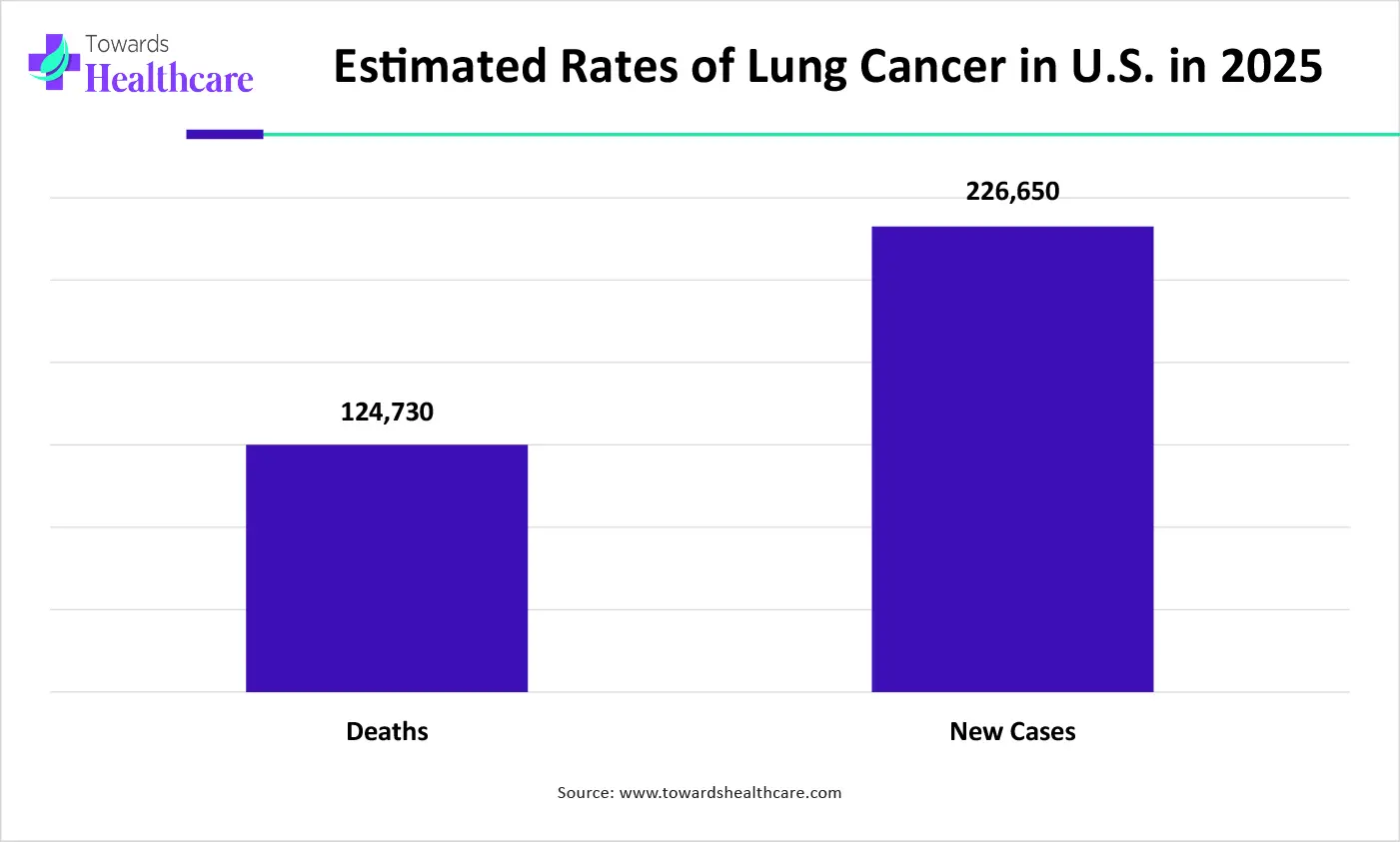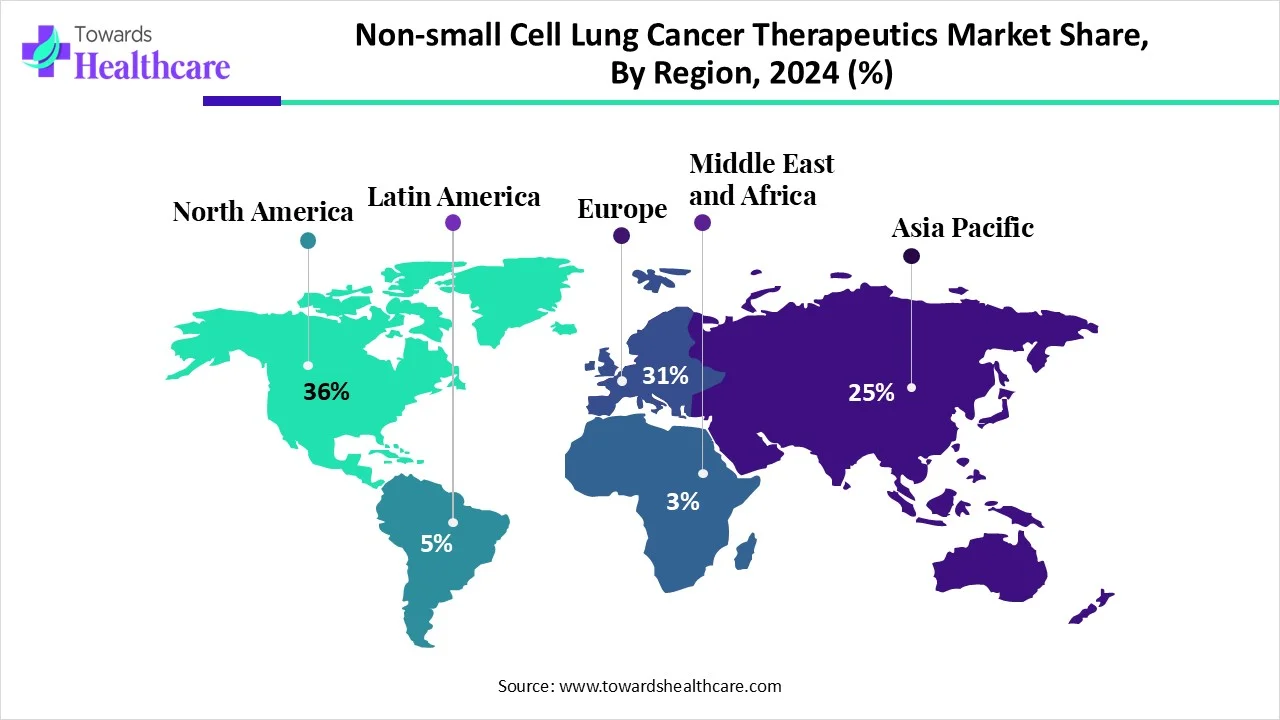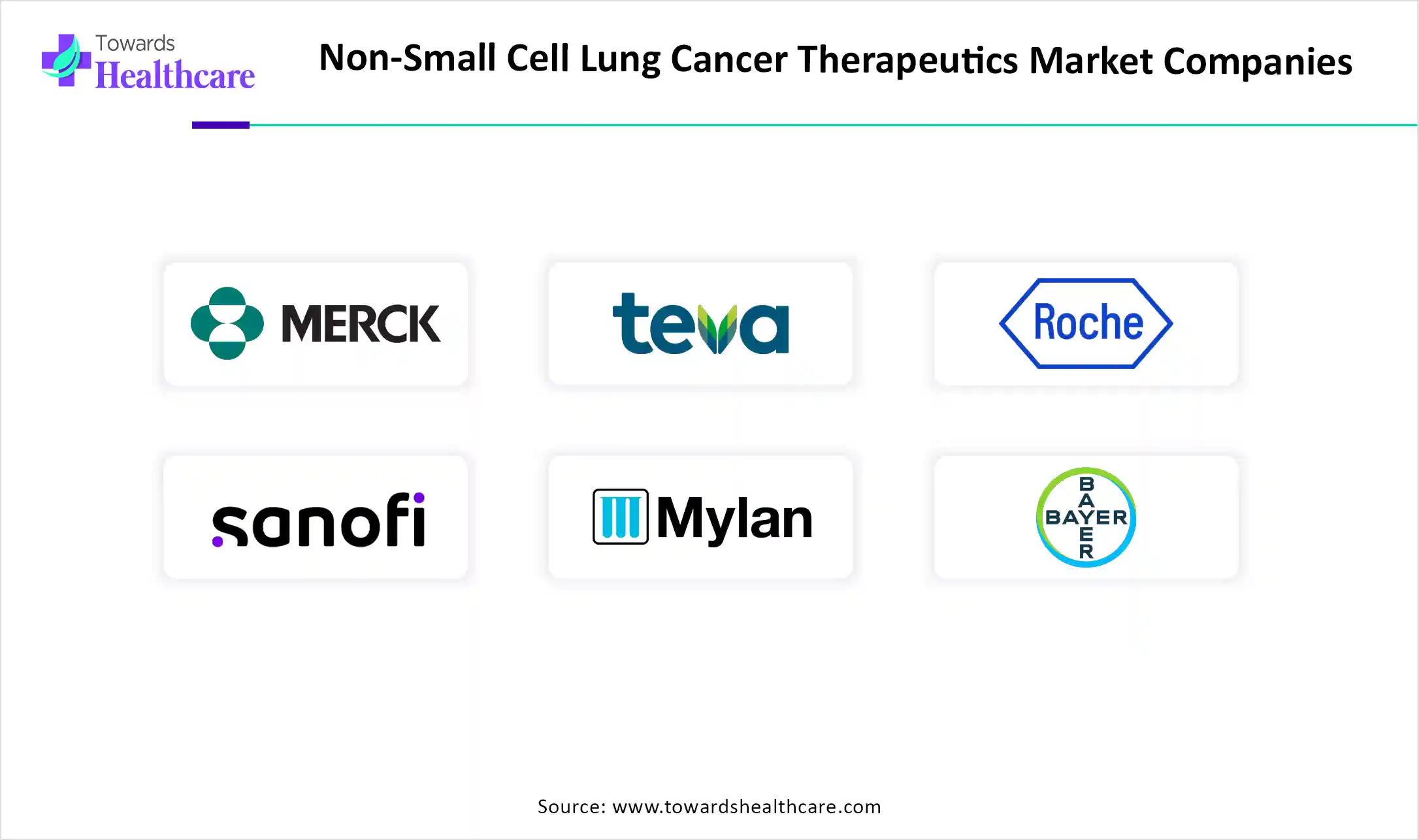December 2025

The global non-small cell lung cancer therapeutics market size is calculated at USD 21.5 in 2024, grew to USD 24.24 billion in 2025, and is projected to reach around USD 71.2 billion by 2034. The market is expanding at a CAGR of 12.74% between 2025 and 2034.

| Metric | Details |
| Market Size in 2025 | USD 24.24 Billion |
| Projected Market Size in 2034 | USD 71.2 Billion |
| CAGR (2025 - 2034) | 12.74% |
| Leading Region | North America share by 36% |
| Market Segmentation | By Type, By Treatment, By Distribution Channel, By Region |
| Top Key Players | Merck & Co., Inc., Teva Pharmaceutical Industries Ltd., F. Hoffmann-La Roche Ltd., Sanofi, Mylan N.V., Bayer AG, Novartis AG, Pfizer Inc., GSK plc, Eli Lilly and Company |
Non-small cell lung cancer (NSCLC) consists of various risk factors such as smoking, genetic, as well as environmental factors. The treatment options provided to the patients depend on the stages of the cancer. Nowadays, the effective management of lung cancer is done with the help of targeted therapy and immunotherapy. At the same time, personalized approaches are also provided by biomarker or genetic testing. These offer enhanced precision by targeting specific mutations. Furthermore, vaccines are also being investigated as the next treatment approach for NSCLC.
There are various applications of AI in lung cancer research. It can be used in domains such as pathomics, genomics, radiomics, transcriptomics, microbiomics, proteomics, immunomics, and metabolomics. At the same time, it can be used in drug discovery, early diagnosis, formulating personalized treatment approaches, and monitoring. Furthermore, it also helps in anticipating responses to the immunotherapies as well as survival rates. Thus, AI plays a crucial role in combating NSCLC, which in turn helps in enhancing patient outcomes as well as quality of life.
Increasing Occurrence of Non-Small Cell Lung Cancer
There is a rise in the occurrence of non-small cell lung cancer, due to which there is an increase in the demand for new diagnostic as well as treatment approaches. At the same time, various awareness programs are being conducted, which increases the demand as well as the use of early diagnosis. This, in turn, contributes to the growing use of various treatment approaches. Furthermore, new personalized treatment options are also increasing. Thus, all the factors drive the non-small cell lung cancer therapeutics market growth.

The graph represents the estimated rates of lung cancer in the U.S. for 2025. It indicates that there will be a rise in cases of lung cancer. Hence, it increases the demand for new therapeutic options for the effective management of lung cancer. Thus, this in turn will ultimately promote the market growth.
Side Effects
The treatment options used for non-small cell lung cancer may have various side effects. These side effects may affect the immune system or even the liver, due to which these treatments may be discontinued. At the same time, nausea or fatigue also reduces the acceptance rate of these treatments, resulting in a restraint on the market growth.
Rising Targeted Treatment Approaches
Due to the increase in non-small cell lung cancer cases, as well as due to side effects associated with certain medications, the demand for targeted and personalized treatment options is rising. This, in turn, increases the research and development focusing on these approaches. Furthermore, this also results in their increased acceptance rates. Thus, new targeted drugs or therapies with enhanced safety and efficacy are being developed along with personalized medications. This, in turn, helps in minimizing the side effects, which helps in improving patient outcomes. Thus, all these factors promote the non-small cell lung cancer therapeutics market growth.
For instance,
By type, the adenocarcinoma segment dominated the market in 2024. The increased cases, along with rising mutations in adenocarcinoma, contributed to the increased use of therapeutics. This enhanced the non-small cell lung cancer therapeutics market growth.
By type, the squamous cell carcinoma (SCC) segment is estimated to be the fastest growing at a notable CAGR during the forecast period. The squamous cell carcinoma incidence is rising, as well as the growing awareness about early diagnosis is also increasing the use of therapeutics for its effective management.
By treatment type, the targeted therapy segment dominated the market in 2024. The targeted therapy provided a reduction in the genetic mutations due to its target-specific action, which in turn, enhanced the patient outcomes as well as market growth.
By treatment type, the immunotherapy segment is anticipated to grow significantly during the forecast period. The use of immunotherapies is increasing as they can be used in the early stages of NSCLC as well as in combination with targeted therapies or chemotherapy, which helps in enhancing the effectiveness of the treatment.
By distribution channel type, the hospital segment dominated the global non-small cell lung cancer therapeutics market in 2024. Hospitals provided various services from diagnosis to treatment. At the same time, the advanced treatment approaches with specialized personnel helped in the management of NSCLC cases.
By distribution channel type, the drug store and retail pharmacy segment is predicted to grow significantly during the forecast period. The drug store and retail pharmacy are providing various medications to the NSCLC patients with enhanced accessibility. This, in turn, promotes the market growth.

North America dominated the non-small cell lung cancer therapeutics market share by 36% in 2024. North America consisted of well-established industries along with new technologies, as well as skilled personnel. This increased the development as well as production of various non-small cell lung cancer therapeutics, contributing to the market growth.
The industries in the U.S. are well-developed, due to which the development of new therapeutics is rising. At the same time, they also enhance the production rate with the use of advanced technologies, by maintaining their quality and safety with the help of skilled personnel.
Due to increasing interest in the development of new personalized and targeted therapeutics, the industries in Canada are focusing on the research and development of the same. This increases the collaboration between the companies.
Asia Pacific is estimated to host the fastest-growing non-small cell lung cancer therapeutics market during the forecast period. Asia Pacific is experiencing a rise in the incidence of lung cancers. This, in turn, increases the demand for various therapeutics. Thus, this enhances the market growth.
The healthcare sector in China is adopting various advanced technologies to deal with the increasing occurrences of lung cancer. These technologies are being utilized to enhance the development and reduce the errors associated with the development of therapeutics.
The rising incidence of lung cancer in India is increasing the demand as well as the development of new therapeutics. At the same time, to make these advancements affordable government is also providing its support.
Europe is expected to grow significantly in the non-small cell lung cancer therapeutics market during the forecast period. With the increasing prevalence as well as awareness in Europe, the demand for the use of personalized treatment options is growing. This promotes the market growth.
The production, as well as research and development for personalized treatment options, is increasing in Germany. This is due to growing incidences of non-small cell lung cancer cases. Thus, these developments are supported by the funding provided by the government.
The increasing awareness within the population is increasing the demand as well as the use of personalized treatment approaches. At the same time, new such medications are being developed, increasing the clinical trials supported by the regulatory bodies.
The Middle East & Africa are expected to grow at a notable rate in the foreseeable future. This is due to the increasing cases of NSCLC and growing research and development activities. Favorable government support and increasing investments by government and private organizations augment the market. Prominent players collaborate to access advanced technologies, and foreign players aim to expand their geographical presence in the Middle East & Africa. Institutions conduct seminars, workshops, and conferences to share the latest updates on NSCLC therapeutics.
Lung cancer accounts for the seventh most common cancer type in the Gulf Cooperation Council (GCC) countries, with an average of 4.6% of total cancer cases annually. The major cause of NSCLC is smoking. About 11.9% of the total adult population of the UAE smokes.
The World Health Organization (WHO) reported that the prevalence of lung cancer in Saudi Arabia is 4.3 per 100,000 people. In May 2025, ImmunityBio, Inc. signed a Memorandum of Understanding (MoU) with the Ministry of Investment of Saudi Arabia, King Faisal Specialist Hospital & Research Centre, and King Abdullah International Medical Research Center to launch the FDA-approved Cancer BioShield Platform in Saudi Arabia and the Middle East.

By Type
By Treatment
By Distribution Channel
By Region
December 2025
November 2025
November 2025
November 2025